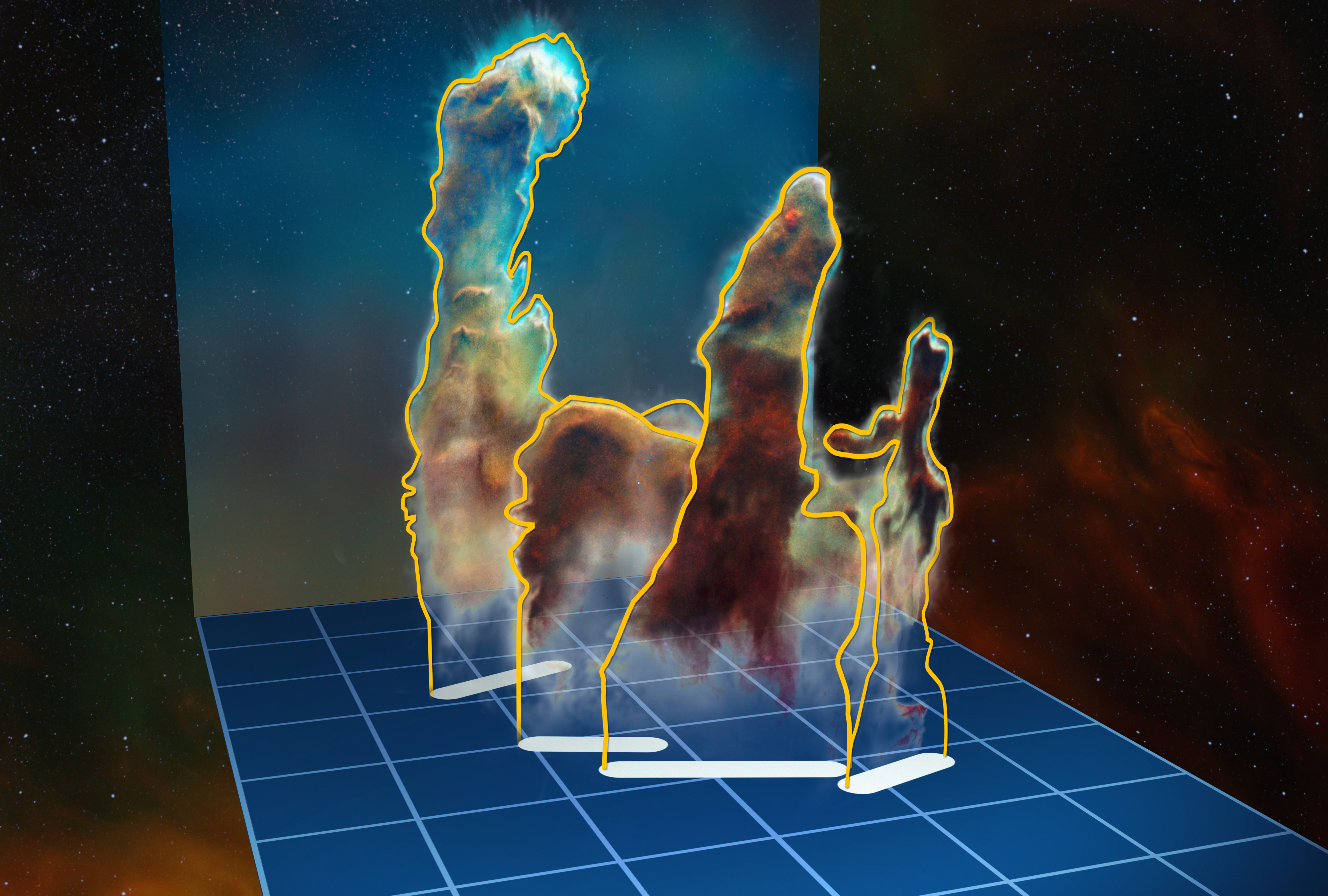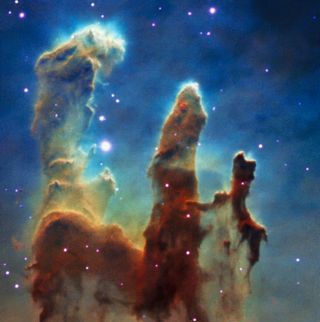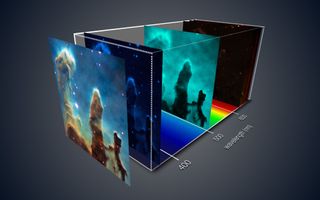Amazing 3D View of Iconic 'Pillars of Creation' Predicts Cosmic Demise (Video)

New images provide the first complete 3D view of the Pillars of Creation — some of the most iconic cosmic structures ever studied — and suggest that the glorious protrusions may be around for only another 3 million years.
The new images reveal never-before-seen stars in the thick, fingerlike gas clouds, as well as new details about their orientation in space. You can get a close look at the formation in a new video of the Pillars of Creation.
The new observations also show that the humongous structures are slowly crumbling, and may disappear completely in 3 million years — a blink of an eye on cosmic timescales. [See the Hubble Telescope's Breathtaking Pillars Of Creation View]
The Pillars of Creation gained worldwide fame on Earth when they were imaged by the Hubble Space Telescope in 1995, and in 2014, Hubble used its updated hardware to produce even higher definition images of the region.
These cosmic protrusions are composed of dust and gas, and are part of a larger region known as the Eagle Nebula — a fertile region of new star formation. The star cluster NGC 6611 is a product of this area's star-forming tendencies.

When hot and massive new stars begin burning in gas clouds like the Eagle Nebula, they give off strong stellar winds and powerful radiation that disperse much of the gas that surrounds them.
Denser pockets of gas in these star-forming regions can sometimes withstand the radiation and stellar wind. Such pockets can then act as a shield to the gas that lies behind it. As a result, in these regions of star formation, astronomers often see column-shaped gas structures. These protrusions are sometimes called "tails," "elephant trunks" or in this case "pillars," according to the statement from ESO.
Get the Space.com Newsletter
Breaking space news, the latest updates on rocket launches, skywatching events and more!
The "shield" of the left-most pillar is the upper tip, which the new images show is oriented toward Earth.
"This tip is bearing the brunt of the radiation from NGC 6611's stars, and as a result looks brighter to our eyes than the bottom left, middle and right pillars, whose tips are all pointed away from our view," the statement said.
The powerful wind and radiation coming from these stars may eventually crumble those shields of dense gas. The new MUSE data has allowed astronomers to measure the rate at which the Pillars of Creation are being destroyed in this way: they lose about 70 times the mass of the sun every million years.

The Pillars of Creation are currently estimated to contain about 200 times the mass of the sun. If the current rate of evaporation continues, these gaseous fingers could be completely destroyed in about 3 million years.
That is, if the Pillars haven't already been destroyed by a nearby supernova explosion observed in 2007. It's possible the stellar explosion has already wiped out the gas clouds; but, because they are located 7,000 light-years from Earth, astronomers can see them only as they existed 7,000 years ago. The supernova explosion is thought to have taken place between 6,000 and 9,000 years ago, so it may be another 1,000 years before astronomers know if the Pillars are still standing.
The new study appeared in the April 30 issue of the journal Monthly Notices of the Royal Astronomical Society.
Follow Calla Cofield @callacofield. Follow us @Spacedotcom, Facebook and Google+. Original article on Space.com.
Join our Space Forums to keep talking space on the latest missions, night sky and more! And if you have a news tip, correction or comment, let us know at: community@space.com.

Calla Cofield joined Space.com's crew in October 2014. She enjoys writing about black holes, exploding stars, ripples in space-time, science in comic books, and all the mysteries of the cosmos. Prior to joining Space.com Calla worked as a freelance writer, with her work appearing in APS News, Symmetry magazine, Scientific American, Nature News, Physics World, and others. From 2010 to 2014 she was a producer for The Physics Central Podcast. Previously, Calla worked at the American Museum of Natural History in New York City (hands down the best office building ever) and SLAC National Accelerator Laboratory in California. Calla studied physics at the University of Massachusetts, Amherst and is originally from Sandy, Utah. In 2018, Calla left Space.com to join NASA's Jet Propulsion Laboratory media team where she oversees astronomy, physics, exoplanets and the Cold Atom Lab mission. She has been underground at three of the largest particle accelerators in the world and would really like to know what the heck dark matter is. Contact Calla via: E-Mail – Twitter